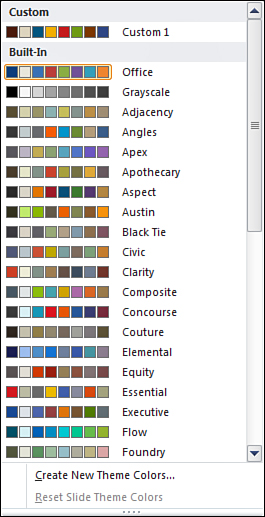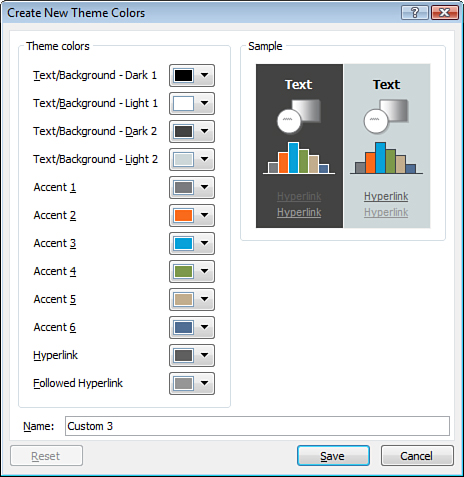If PowerPoint’s built-in themes don’t suit your
needs, you can customize the fonts, colors, and effects in a theme and
create your own theme.
1. Customizing Theme Color Schemes
Every PowerPoint theme includes a color scheme, a set of 12 coordinated colors used in the following parts of your presentation:
Text and background (two light and two dark)
Accents (six colors for graphs, charts, and other objects)
Hyperlinks
Followed hyperlinks
Applying a New Slide Color Scheme
If you don’t like the colors in a particular theme, you can apply another color scheme.
To apply a new scheme, follow these steps:
1. | Click the Colors button on the Design tab. A gallery of color schemes displays, as shown in Figure 1.

|
2. | Pause your mouse over each scheme to preview it on your presentation.
|
3. | Click the scheme you prefer to apply it to your presentation.
|
Applying Multiple Color Schemes to a Single Presentation
PowerPoint also enables you to apply multiple color
schemes within a single presentation. As with applying multiple themes,
be sure that you have a good reason to do this before applying many
different colors to your presentation. To apply multiple color schemes
to your presentation, follow these steps:
1. | Select
the slides to which you want to apply a separate color scheme. You can
do this on the Slides tab or Outline tab on the left side of your screen
or in Slide Sorter view.
|
2. | On the Design tab, click the Colors button. The theme colors gallery displays.
|
3. | In
the gallery, right-click the new color scheme, and choose Apply to
Selected Slides. PowerPoint applies the color scheme to only the
selected slides. The unselected slides retain the original color scheme.
|
To return to a single color scheme, select that scheme from the gallery.
|
Although the capability to apply multiple color
schemes to your presentation adds flexibility and creativity, be sure
not to overdo it. Consider carefully before applying more than one color
scheme to verify that your presentation is still consistent and
readable.
|
Creating a Custom Color Scheme
Occasionally, you might want to customize the
individual colors in a color scheme. For example, you might like a
particular scheme but want to modify one of the text/background colors.
Or you might want to use colors that match your company’s logo or other
design elements.
To create a custom color scheme, follow these steps:
1. | On the Design tab, click the Colors button to open the colors gallery.
|
2. | In the gallery, select Create New Theme Colors to open the Create New Theme Colors dialog box. Figure 2 shows this dialog box.

|
3. | In
the dialog box, select theme colors for text, backgrounds, accents, and
hyperlinks from the drop-down lists. The Sample box previews your
selections.
|
4. | Enter a name for your new color scheme.
|
5. | When
you’re happy with your choices, click the Save button. Your new color
scheme now displays as a custom color scheme, available for selection
from the gallery.
|
To edit custom color schemes, right-click the
appropriate color scheme in the gallery, and select Edit from the
shortcut menu. Make your changes in the Edit Theme Colors dialog box,
and click Save.
To delete a custom color scheme, right-click the
appropriate color scheme in the gallery, and select Delete from the
shortcut menu. Click Yes to confirm the deletion. The custom scheme no
longer displays in the gallery.